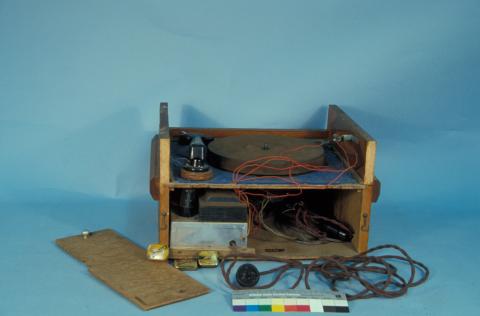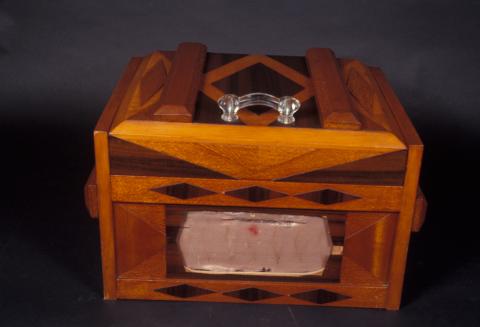Treatments
Before treating a wooden object examine it carefully, noting significant features which may affect the type of treatment chosen. Factors such as the type of original surface, the presence of maker’s marks, evidence of usage and previous repairs or alterations need to be considered when deciding on a treatment strategy (Figure 4).
Figure 4: Homemade gramophone manufactured from a variety of Western Australian timbers.
(a) Before treatment.
(b) After treatment.
Cleaning
As wooden objects and certain surface finishes are particularly sensitive to moisture, dry cleaning methods are recommended. The abrasive nature of dust must also be considered when contemplating cleaning, especially with objects that have highly polished surfaces. Only clean wooden surfaces that are either unfinished, painted or those with a robust surface finish.
For all wooden surfaces, but especially unsealed and polished surfaces (including French polished), the best approach is to use a soft lint-free cloth or a soft brush and vacuum cleaner to remove dust and loose dirt.
Objects that have a surface that is not permeable to water (for example, waxed, polyurethane finish) may be cleaned using the approach described above or by using a sponge that has been slightly moistened in water. Do not allow water to remain on the surface of the wood.
Do not use wet cleaning techniques on polished wooden surfaces.
Consolidation or Repair
Wooden objects requiring conservation or restoration can range from large structures and vehicles to extremely fine, delicate carved objects.
Understanding an object’s past and possible future roles may affect the type of treatment undertaken. For instance, repairs to a horse-drawn vehicle that is to be used will differ from those for a similar object that is to be placed on static display.
There is a variety of techniques and consolidants that may be used to ‘repair’ damaged or friable wood. These repairs include consolidating friable components, filling gaps and gluing dislodged pieces. Materials used to repair wooden objects include resins, waxes and adhesives. Some of these, not all of which are recommended for use by the way, are listed below:
- resin and wax;
- polyester resins (for example, Paraloid B72);
- polyvinyl butyral;
- polyvinyl acetate;
- epoxy resins (for example, Araldite);
- cellulose nitrate; and
- silicone rubbers;
Unfortunately, inappropriate materials are often used to replace missing wood or as fillers for gaps and cracks. Some of these include newspaper, plaster, concrete, bitumen and motor car body filler.
The type of adhesive and the filler type will be determined by the proposed use of the object. If the object is to perform a structural role then the combination of materials will be different from those that would be used for non-structural fills. For structural fills where movement of the wood is likely to be slight, an epoxy resin or micro-balloon fill has been recommended (Grattan and Barclay 1988). The use of a fill of epoxy resin and sawdust is described elsewhere (see the chapter Case Studies). A summary of traditional fillers is provided in Appendix 5.
As the techniques and chemicals used in consolidation are specialised, seek the advice of a conservator.
Furniture
Usually older style furniture is constructed and held together by dowels or pegs and animal-based glue. Although these glues are quite strong, they deteriorate with age, become very brittle and are easily broken, especially if excessive stress is placed upon the joints. Screws, brackets and hold down clamps (table tops) were used in later furniture.
If restoring period or historic furniture, take care to use correct restorative methods. Incorrect procedures can undermine both the value and the historical importance of the furniture. Research into the methods of construction of furniture is very important, often yielding valuable information which can guide any restoration process. For example, if animal glues and dowelling were used originally, use the same materials in any restoration/conservation treatment. If a new piece has to be constructed and fitted to an old object, use original methods. Retain any remaining damaged, original pieces for future repairs.
Note, despite the recommendation above, there is some support for using modern materials so that repairs and restoration work can be distinguished from the untreated components.
Staining and Marking of Furniture
Staining or marking is virtually inevitable on furniture that has been used throughout its life. These stains and marks often enhance the character and patina of the piece. Some attempts to eradicate staining and marks have damaged some fine pieces of furniture.
As the removal of stains and marks may involve the loss of both wood and patina, consider the available options before bringing the sander and sandpaper into action. Seek advice from a conservator. Drastic treatment may result in the loss of value of the piece, especially if problems are encountered with reproducing the surface finish and colour (often difficult tasks).
Inlays
A variety of materials, including brass, ivory and different woods, is used for inlays. Their differing compositions and variations in the way they react to changing environmental conditions complicate repairs. Extremes of temperature and humidity will affect each of the materials differently.
The treatment of inlays is highly specialised. Seek professional advice before attempting any treatment.
Surface Finishes
Surface finishes applied to wooden objects include:
- waxes;
- shellac (French polish);
- polyurethanes;
- paints;
- oils; and
- veneers.
Exercise care when selecting a surface coating to apply to a wooden object. The purpose of the coating may be to either protect a friable surface or to confer a pleasant sheen to a surface that has become dull. In the past it was customary to apply drying oils, such as linseed oil, or waxes such as beeswax. The former suffer from the disadvantage that they yellow with age, a tendency that is accentuated under tropical conditions and they become very difficult to remove after prolonged ageing. The latter often leave the surface of the wood slightly sticky. Sticky areas attract dust, particularly in the crevices in the wood. This creates favourable conditions for the laying of eggs by wood-boring insects.
Depending on the nature of the object, waxes may be suitable as protective surface coatings as long as care is taken to choose a suitable wax mixture which leaves a relatively hard, non-sticky surface finish. Such a wax mixture may be prepared using some commercially available synthetic waxes. A useful formulation and method of preparation is given below:
| microcrystalline wax | 100 g |
| polyethylene wax | 25 g |
| white spirit | 230 g |
- melt the waxes together and stir well to ensure that they are thoroughly mixed; and
- pour the molten mixture quickly into the white spirit and stir constantly while cooling so that a smooth paste is obtained.
Several varieties of these waxes are available and the sheen of the resultant wax film can be varied by altering the grades or the proportions of the waxes used. The high dispersive power of the microcrystalline wax helps to remove ingrained dirt from the wood as well as providing a protective coating of pleasant appearance.
Formulations made by mixing beeswax and carnauba with turpentine have been found to work well.
Several suitable commercial wood waxes are available and these give satisfactory results. Avoid waxes containing silicones (this is usually stated on the container) as they are very difficult to remove. This may cause problems if subsequent treatments are necessary.
Only use coloured waxes after careful thought as these obviously alter the appearance of the wood. Clear finish waxes are preferred.
French polished furniture has a beautiful and lustrous finish but it can be damaged easily. As French polish is shellac dissolved in methylated spirit, any wet object or alcohol will either mark or dissolve the surface. Restoring damaged surfaces will usually require the services of a professional restorer.
Polyurethane finishes are clear, hard and resistant to wear but are virtually impossible to remove without damage to the underlying wood. Their use on period or antique furniture is not recommended.
Oil-based finishes also give a lustrous shine but unless wiped down carefully can leave a ‘tacky’ finish which will attract dust. Oils which may be used on furniture include poppy seed, walnut and Danish oils.
Veneer is a thin layer, normally of some exotic timber, laid and glued over a frame of a different type of wood. If animal glue has been used and is deteriorating, the veneer may lift. If regluing is attempted, all traces of the old glue must be removed to ensure a flat finish is obtained. Refer large areas of lifting veneer to experts in the area.
Upholstery
Upholstery is a general term which includes carpets, bed hangings, curtains, chairs, sofas and the components of seat furniture. Information concerning the deterioration, care and conservation of these objects may be obtained by reading the appropriate chapters that deal with the particular material types associated with these objects.
Discussion in this section concentrates on the wooden frame, rather than with the webbing, springs, stuffing, lining, cover and other non-wood upholstery components. Despite this focus, these latter components are important (Burgin 1990, Twichel 1990, Perkins 1990). Some general aspects related to their care and conservation are listed below:
- if extremely disintegrated material is replaced, clean and store it;
- use materials such as plywood and perspex to support deteriorated webbing;
- use soft brushes and low suction vacuum cleaning to clean stuffing;
- place and mould stuffing to its original shape during replacement;
- stabilise acidic hessian by using water poultices; and
- use ethafoam if reconstruction of the under-upholstery is necessary for display purposes and the original materials are unable to be used.
As long as the original fabric has been retained, the colours, patterns and types of textiles used on covers often provide evidence of the style of a period. The conservation of covers is somewhat contentious, especially the issue of removal of the cover for treatment. Replacement is often difficult and cannot always be accomplished. Apart from cleaning robust covers with soft brushes and low suction vacuum cleaners their conservation is best left in the hands of conservators.
The frame can provide useful information about the history of an object. Breaks in the joints or members and nailing patterns, for instance, may give an insight into past wear, abuse and repairs.
Repairing a frame raises many ethical questions regarding the use of adhesives, the replacement of parts and the general extent of intervention (James 1990, Podmaniczky 1990, Graves 1990). The following principles are useful guides when considering conservation of a frame:
- if part of the frame has to be replaced, document this and retain the removed section;
- minimise intervention so that as much of the original object is retained as possible;
- if an adhesive is required for a mechanical joint, use a reversible adhesive, such as PVA;
- analyse and document any original adhesive;
- strengthen weak components by using metal plates to bridge joints or low molecular weight consolidants; and
- when re-upholstering, minimise damage to the frame by using the original holes or by nailing into plugs of white pine which have been used to fill holes.
Heavy Vehicles or Machinery
Although every artefact must be assessed individually, repairs to heavy wooden equipment and horse-drawn vehicles normally require strong consolidating agents. As maximum strength is required, animal glue is not recommended (see the chapter Case Studies).
The application of oils to the wood is not advised as dust quickly adheres to it. This in turn attracts moisture and subsequent mould development. Preventive measures, such as those outlined earlier in this chapter are recommended (see the chapter Preventive Conservation: Agents of Decay).














